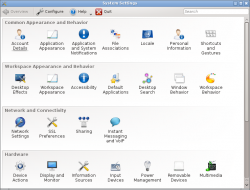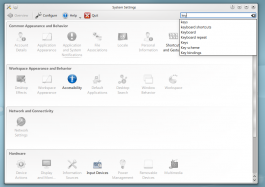Arranjament del sistema
Característiques
- Centre de Control per a la configuració global de la plataforma KDE
- Personalitzar i gestionar l'escriptori en un lloc convenient
- La funció de cerca ajuda a reduir les configuracions probables
Cerca
Arranjament del sistema té una funció de cerca per ajudar a trobar un ajust en concret. Simplement escriviu una paraula clau en el camp de cerca a la barra d'eines i Arranjament del sistema mostrarà els mòduls que contenen la paraula clau i ocultarà els que no. Als mòduls també s'hi pot arribar a través de KRunner.
Categories
Aparença i comportament
Detalls del compte

Configura la informació d'usuari, contrasenya i rutes. També podeu establir els proveïdors d'escriptori social. Aparença de les aplicacions

Configura l'estil, els colors, les icones, el tipus de lletra i les emoticones per a les vostres aplicacions.
Maquinari
Dispositius d'entrada

Configura el teclat, el ratolí i el joystick.
Administració del sistema
Pantalla d'inici de sessió

Configura el gestor d'accés (KDM).. Engegada i aturada

Configura el comportament del sistema quan s'engega o s'atura.
Moviments del ratolí
- KDE SC versió 4.4.4
El lloc on començar és «».
Activar els moviments de ratolí
A la cantonada inferior esquerra de la pantalla hi ha un botó . Assegureu-vos que la caixa està activada. Establiu el temps d'espera que millor us sembli. El botó dret del ratolí pot ser diferent, jo he triat 3 per usar el botó dret del ratolí. Si voleu que els moviments del ratolí s'activin automàticament, activeu la caixa «Inicia el dimoni d'accions d'entrada en iniciar la sessió».
Creating the Mouse gestures actions group
Right click on the left pane (in an empty area under the list of action groups) and choose , rename that group to "Mouse Gestures" and check the checkbox attached to its name.
Creating a new mouse gesture
From now on I will assume that the new group is called "Mouse Gestures". Right click on and choose (here there are three options but I didn't manage to work with "Send Keyboard Input") using "Command/URL" or "D-Bus Command" you will need to create a gesture and bind an action to it.
To create the gesture
Click on your and select the tab. in the bottom of the screen there is an button (click it). In the box that just opened draw your gesture using the left mouse button.
To bind an action
if you chose simply enter that command/url under the tab at the field.
Examples using Command/URL
Close window
This command will let you close the next window you mouse click on.
Command/URL: wmctrl -c :SELECT:
to close the active window
Command/URL: wmctrl -c :ACTIVE:
Translate clipboard content
This command will display a translation of the current clipboard content.
- Required for this are:
- xclip
- libtranslate
Command/URL: kdialog --title "Translation" --msgbox "`xclip -o | translate -f en -t he -`"
Replace 'en' and 'he' with the desired source and destination language, if you are not sure, a full list of language codes is available from the ISO 639-2 list.
Examples using D-Bus
If you chose D-Bus, here are few examples.
Finding out what to fill where, is done with the help of the "Launch D-Bus Browser", using that browser you can find what method you wish to call in what application object. Using D-Bus we need to fill some fields, the field name will be regular and the content italic.
Runner
This will display the Runner dialog.
Remote Application: org.kde.krunner
Remote Object: /App
Function: org.kde.krunner.App.display
Audacious next/previous/pause/play/stop/repeat track
Remote Application: org.mpris.audacious
Remote Object: /Player
Function: org.freedesktop.MediaPlayer.Next (replace Next with Prev/Pause/Stop/Play/Repeat)
Audacious PlayPause track
If not playing will play, if playing will pause.
Remote Application: org.mpris.audacious
Remote Object: /org/atheme/audacious
Function: org.atheme.audacious.PlayPause
display the actions pop-up. (I am using that to search and translate words)
Remote Application: org.kde.klipper
Remote Object: /klipper
Function: org.kde.klipper.klipper.showKlipperManuallyInvokeActionMenu



